It’s alive
Let’s bring our bird alive with code!

What is all this about?
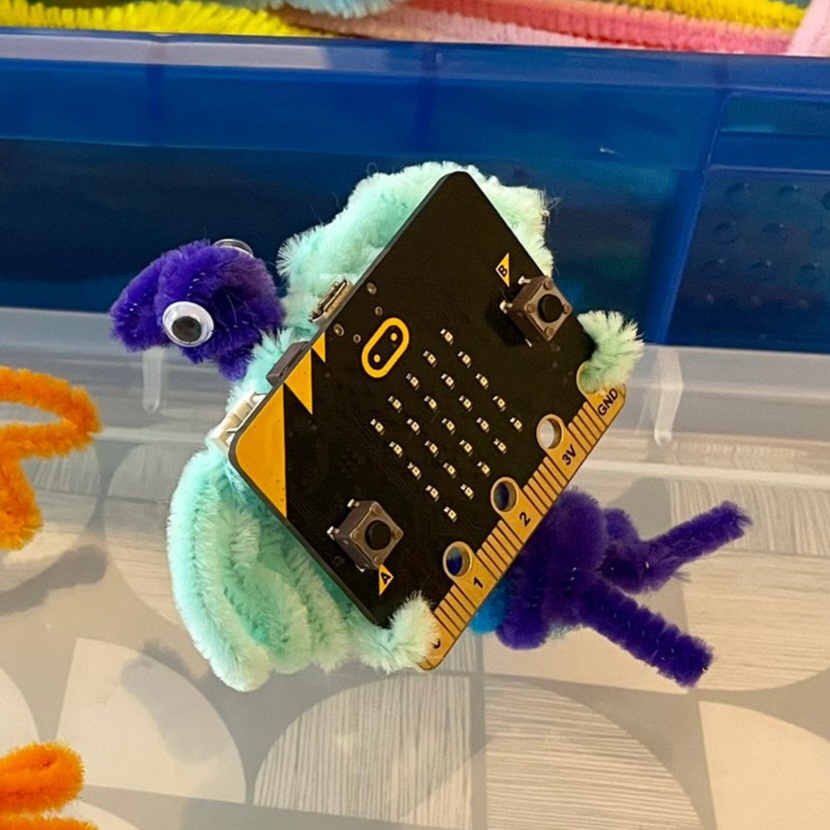
We’re building a beautiful flock of unique, original birds.
Your job, as a creator of one of the birds, is to think like a bird and programme the micro:bit to react to the world like a bird. You might also find that you have responsibilities to the flock too, like sharing useful information.
The micro:bit can communicate wirelessly with other micro:bits using radio. There will be a secret micro:bit in the room broadcasting radio messages to all the birds denoting different events like “hi everyone” or “there is a cat around”.
Apart from that, the micro:bit contains other sensors that your bird will react to, for example, birds don’t like to be shaken! (we assume… no birds were harmed in the making of this workshop - though they may have been subjected to some unpleasant sounds from nearby micro:bits!).
To programme the micro:bit with Python we use MicroPython (click here for more info) and our brand new Python Editor (click here for more info).
First steps - Load the starter project into the editor
Okay, so the first step is to open the micro:bit Python Editor:
https://python.microbit.org 👈 🐍
To start the activity we first need to load a project hex file into the editor.
Right click on this link and select “Save Link As” to save the hex file to your laptop: https://github.com/microbit-carlos/microbit-bird-activity/raw/main/src/bird/bin/flockbird.hex
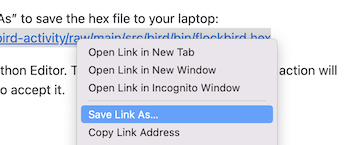
And then drag and drop the hex file to the Python Editor. The editor might warn you that this action will replace the project, you can click “Replace” to accept it.
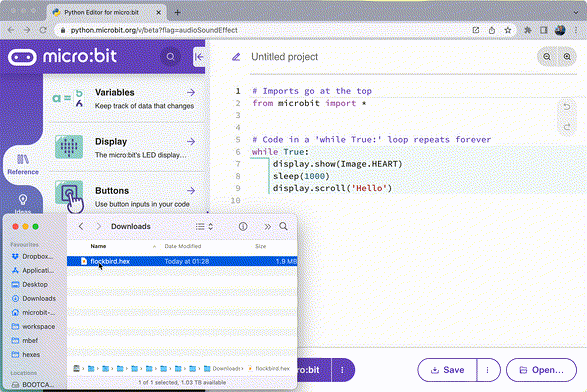
So… What am I looking at?
The loaded hex file contains two Python files, to see them let’s go to the “Project” section on the left sidebar:
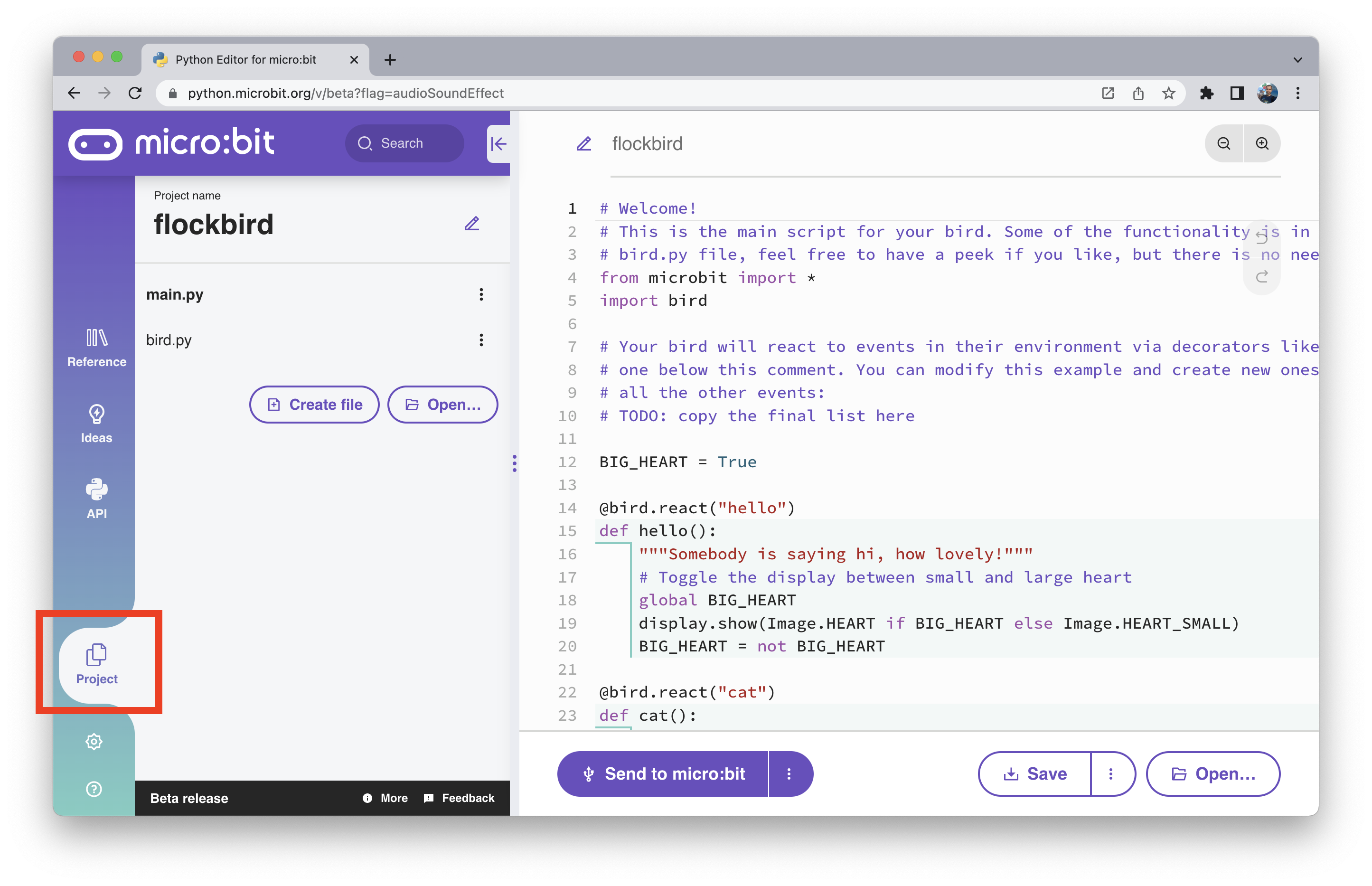
In this view you can switch between the main.py file and the bird.py.
- The
bird.pymodule contains some functionality for the bird to be able to react to the world. - The
main.pyfile is the main code we will be working on.
Both files have been commented to help clarify some of functionality, but there is no need to familiarise yourself with these yet, as we’ll work through the files as part of the activity.
The sidebar also has other useful sections:
- Reference: A place to explore the features of your micro:bit with Python
- API: The micro:bit MicroPython API developer documentation
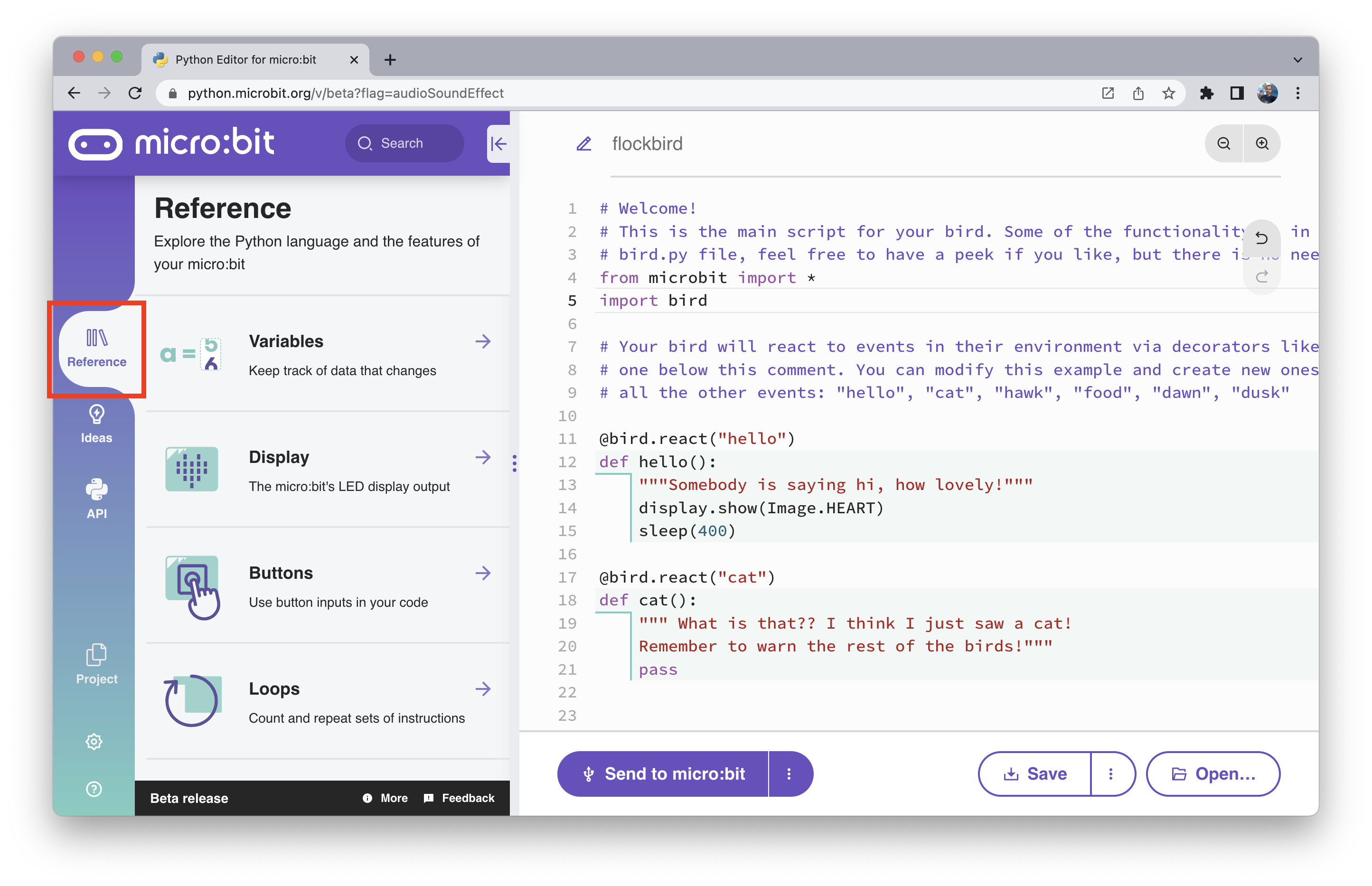
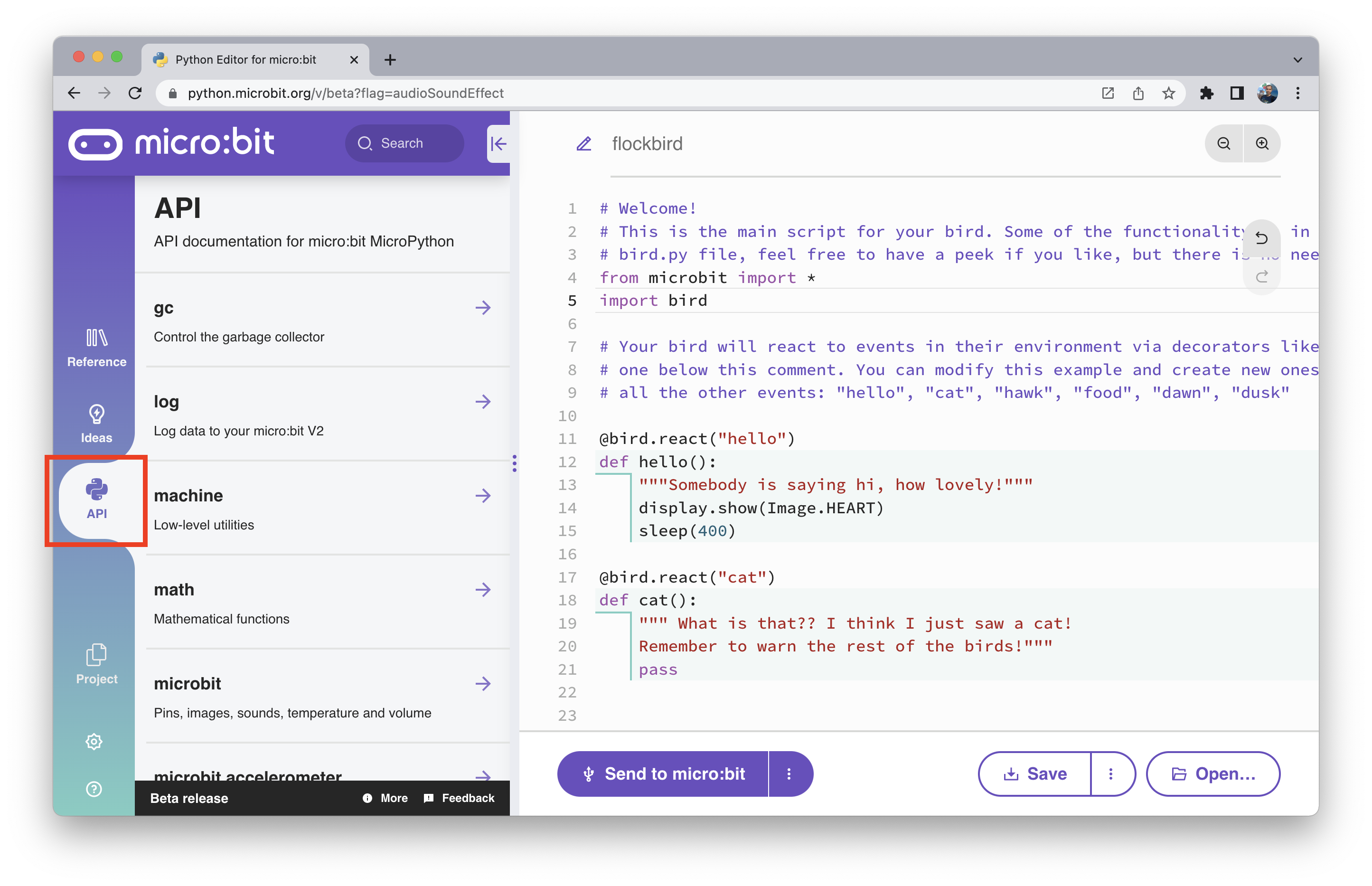
Reacting to events
You’ll see at the top of main.py a function called hello() with a decorator
on top @bird.react("hello"):
@bird.react("hello")
def hello():
"""Somebody is saying hi, how lovely!"""
display.show(Image.HEART)
sleep(400)
When the bird detects a hello message from the airwaves, it will run this function and show a heart image in the micro:bit display for 400 milliseconds.
Exercise:
Birds can be very chatty, so your neighbours might be saying hello quite often.
Can you think of a way to alternate between showing `Image.HEART` and
`Image.HEART_SMALL`? That way it'll look like a beating heart!
When you code is ready, click the purple “Send to micro:bit” button.
If WebUSB is not available in your browser, you can click the “Save” button
to download a hex file, and then copy that file into the MICROBIT USB drive.
What was that! A cat?
There are several events the bird can react to, and seeing a cat is quite important for bird survival!
Exercise:
Let's do the following:
- Copy and paste the "hello" example
- Replace the function name to `def cat():`
- Change the decorator argument from "hello" to "cat".
What do you think the bird should do in this case?
For some examples of thing you can output with the micro:bit, check out the
"Display" and the "Sound" entries from the "Reference" section of the left
side bar.
You can also find a quick list of snippets in the
MicroPython page.
Assuming we’re the kind of bird that likes our local fellow neighbour birds, we also want to warn other birds around us, let’s do that by adding by this line at the end of the function:
bird.warn_about_cat()
If you don’t want to wait until a cat comes around, you can test your decorated function by executing it.
Using the REPL is also really handy for calling your cat() function.
Instructions on how to access the REPL are in the
Trying Sound Effects in the REPL section.
There are more events to explore, if you’d like to go through these now you can check them out in the More events, more sounds section.
Bird Mood
We’ve learned how to react to environment events (received via micro:bit radio), what about things that happen directly to our bird?
Let’s look further down main.py and we’ll find this infinite loop.
while True:
# Look inside yourself and listen, how is your bird feeling?
bird_mood = bird.current_mood()
if bird_mood == "chill":
display.show(Image.HAPPY)
sleep(100)
The function bird.current_mood() uses the micro:bit on board sensors to
figure how your bird is doing.
Exercise:
Birds don't like to be shaken, so "angry" can also be one of the bird moods
to code.
Let's expand that "if" statement with an "elif" and do something else when
the bird is "angry".
SoundEffects
But hold on. What’s with all these images on their screens? Aside from their
uncanny ability to fly (sorry Kiwi, Ostrich, Kakapo, Penguin, etc :( )
birds are probably most famous for the sounds they make.
The micro:bit V2 has a built-in speaker, and a lot of the fun of building birds is giving them a unique voice.
To do that we can create instances of the SoundEffect class from the
audio module, which can be played with the audio.play() function.
The arguments to SoundEffect describe how the sound is generated, indicating
the duration of the sound, its starting and end frequencies and volume,
their rate of change over time (shape), the wave type,
and any additional effects applied to the sound generation (fx).
audio.play(audio.SoundEffect(
freq_start=400,
freq_end=900,
duration=1000,
vol_start=255,
vol_end=0,
waveform=audio.SoundEffect.WAVEFORM_NOISE,
fx=audio.SoundEffect.FX_TREMOLO,
shape=audio.SoundEffect.SHAPE_LINEAR
))
You can play this SoundEffect, and then change some of the values to see
how that changes the sound.
Info on the current implementation can be found in this preview of the docs: https://microbit-micropython.readthedocs.io/en/v2-docs/audio.html#sound-effects-v2
Trying Sound Effects in the REPL
The Python REPL is a great place to quickly try some Python code. Even though the micro:bit is small, it’s running MicroPython, which gives you full access to a REPL.
To use the REPL, first connect to the micro:bit with the “Send to micro:bit” button. And then press the “Show serial” on the right of the dark box:

Then the three dots menu on the right, and select the “Send Ctrl+C” option:
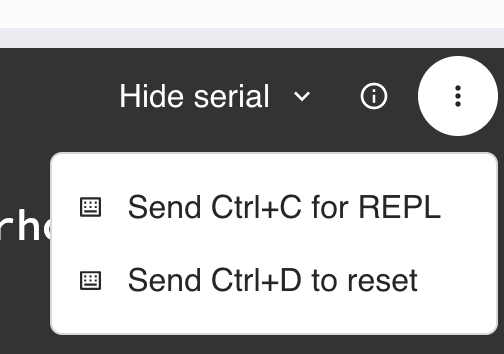
And there we go, the MicroPython REPL, where you can type or paste any Python code you like, and it will execute it inmediately:
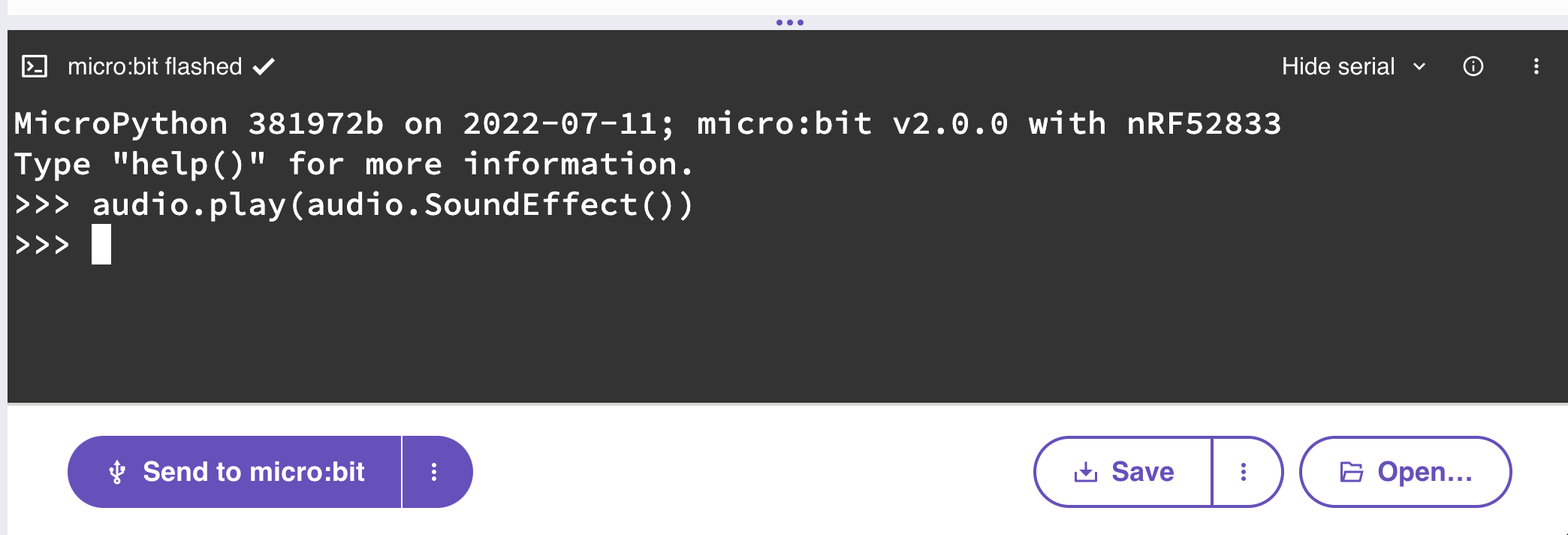
Exercise:
Can you come up with an "angry" sound for the bird mood?
What kind of sound would a bird make if they spot a cat?
There is no “solution” for this exercise, be as creative as you’d like!
Have you tried playing multiple sounds one after another? You can make an ever longer cooler sound 📢.
effect_one = audio.SoundEffect(
freq_start=988,
freq_end=440,
duration=190,
vol_start=255,
vol_end=255,
waveform=audio.SoundEffect.WAVEFORM_SINE,
fx=audio.SoundEffect.FX_VIBRATO
)
effect_two = audio.SoundEffect(
freq_start=2570,
freq_end=440,
duration=874,
vol_start=255,
vol_end=87,
waveform=audio.SoundEffect.WAVEFORM_SAWTOOTH,
fx=audio.SoundEffect.FX_VIBRATO
)
audio.play(effect_one)
audio.play(effect_two)
More events, more sounds
There are other events that can be programmed, the full list is:
hello: Say hi to the flockcat: There is a predator belowhawk: There is a predator abovedawn: It’s time to wake updusk: It’s time to go to sleep
What kind of sounds would you create for each one of these?
You can add more functions with the @bird.react("event") decorator to play
a different Sound Effect on each of these events.